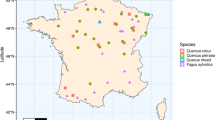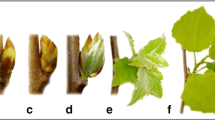Abstract
The widely observed advance in spring budburst across a range of temperate forest species due to climatic warming has received considerable attention. This change in forest phenology has important implications for the choice of species and provenances currently being planted, which need to be suited to both current and future climatic conditions. Using a provenance trial in the south of England, this study assessed variation in the timing of budburst across 23 different European provenances of oak (Quercus robur L. and Q. petraea (Matt.) Liebl.) over 8 years of observations. The order in which the different provenances reached budburst was related to provenance source latitude: the southern provenances were always earlier than those from more northerly latitudes. The statistical technique partial least squares regression was used to identify critical periods of both chilling and warming. A General Linear Model and three-dimensional temperature response surfaces were used to analyse the temporal trends in budburst. There was a negative correlation between the date of budburst and mean daily air temperature in both the chilling and warming periods for all provenances, which was statistically significant for a majority. Spring warming had a larger effect on budburst than winter chilling with a mean spring temperature-driven advance of 3.61 days/°C (standard error = 0.17 days/°C) and mean winter period temperature-driven advance of 0.99 days/°C (standard error = 0.17 days/°C). Surprisingly, there was no statistically significant interaction between mean air temperatures during the chilling and warming phases on the date of budburst.




Similar content being viewed by others
References
Anderson JL, Richardson EA, Kesner CD (1986) Validation of chill unit and flower bud phenology models for ‘Montmorency’ sour cherry. Acta Hortic 184:71–78
Baldocchi D, Wong S (2008) Accumulated winter chill is decreasing in the fruit growing regions of California. Clim Change 87:S153–S166
Cannell MGR (1989) Chilling, thermal time and the dates of flowering of trees. In: Wright CJ (ed) Manipulation of fruiting. Butterworth and Co, London, pp 99–113
Conrad V (1946) Usual formulas of continentality and their limits of validity. Trans Am Geophys Union 27:663–664
Dantec CF, Vitasse Y, Bonhomme M, Louvet JM, Krémer A, Delzon S (2014) Chilling and heat requirements for leaf unfolding in European beech and sessile oak populations at the southern limit of their distribution range. Int J Biometeorol 58:1853–1864
Deans JD, Harvey FJ (1995) Phenologies of sixteen European provenances of sessile oak growing in Scotland. Forestry 68:265–273
Ducousso A, Guyon JP, Krémer A (1996) Latitudinal and altitudinal variation of bud burst in western populations of sessile oak (Quercus petraea (Matt) Liebl). Ann For Sci 53:775–782
Erez A, Fishman S, Linsley-Noakes GC, Allan P (1990) The dynamic model for rest completion in peach buds. Acta Hortic 276:165–174
Fishman S, Erez A, Couvillon GA (1987a) The temperature dependence of dormancy breaking in plants—computer simulation of processes studies under controlled temperatures. J Theor Biol 126:309–321
Fishman S, Erez A, Couvillon GA (1987b) The temperature dependence of dormancy breaking in plants—mathematical analysis of a two-step model involving a co-operation transition. J Theor Biol 124:437–483
Fu YSH, Campioli M, Deckmyn G, Janssens IA (2013) Sensitivity of leaf unfolding to experimental warming in three temperate tree species. Agric For Meteorol 181:125–132
Fu YSH, Campioli M, Vitasse Y, De Boeck HJ, Van den Berge J, AbdElgawad H, Asard H, Piao S, Deckmyn G, Janssens IA (2014) Variation in leaf flushing date influences autumnal senescence and next year’s flushing date in two temperate tree species. Proc Natl Acad Sci USA 111:7355–7360
Furrer R, Nychka D, Sain S (2012) Fields: tools for spatial data. R Package Version 6.7
Guo L, Dai J, Wang M, Xu J, Luedeling E (2015) Responses of spring phenology in temperate zone trees to climate warming: a case study of apricot flowering in China. Agric For Meteorol 201:1–7
Hänninen H (1987) Effects of temperature on dormancy release in woody plants: implications of prevailing models. Silva Fenn 21:279–299
Hänninen H (1995) Effects of climate change on trees from cool temperate regions: an ecophysiological approach to modelling of bud burst phenology. Can J Bot 73:183–199
Hubert J (2005) Selecting the right provenance of oak for planting in Britain. Forestry Commission Information Note. Forestry Commission, Edinburgh
Jenkins GJ, Perry MC, Prior MJ (2008) The climate of the United Kingdom and recent trends. Met Office Hadley Centre, Exeter
Jensen JS, Hansen JK (2008) Geographical variation in phenology of Quercus petraea (Matt.) Liebl and Quercus robur L. oak grown in a greenhouse. Scand J Forest Res 23:179–188
Jones HG (1992) Plants and microclimate: a quantitative approach to environmental plant physiology, 2nd edn. Cambridge University Press, Cambridge
Keeling RF, Piper SC, Heimann M (1996) Global and hemispheric CO2 sinks deduced from changes in atmospheric O2 concentration. Nature 381:218–221
Kirilenko AP, Sedjo RA (2007) Climate change impacts on forestry. Proc Natl Acad Sci USA 104:19697–19702
Kleinschmit J (1993) Intraspecific variation of growth and adaptive traits in European oak species. Ann Sci For 50(Suppl. 1):166–185
Leinonen I, Hänninen H (2002) Adaptation of the timing of bud burst of Norway spruce to temperature and boreal climates. Silva Fenn 36:695–701
Liepe K (1993) Growth-chamber trial on frost hardiness and field trial on flushing of sessile oak (Quercus petraea Liebl). Ann Sci For 50:208–214
Lindner M, Fitzgerald JB, Zimmermann NE, Reyer C, Delzon S, van der Maaten E, Schelhaas MJ, Lasch P, Eggers J, van der Maaten-Theunissen M, Suckow F, Psomas A, Poulter B, Hanewinkel M (2014) Climate change and European forests: what do we know, what are the uncertainties, and what are the implications for forest management? J Environ Manag 146:69–83
Lines R (1992) The choice of seed origin by species. In: Gorden AG (ed) Seed manual for forest trees. Forestry Commission Bulletin no 83. Forestry Commission, Edinburgh
Luedeling E (2012) Climate change impacts on winter chill for temperate fruit and nut production: a review. Sci Hortic-Amst 144:218–229
Luedeling E (2013) Chillr: statistical methods for phenology analysis in temperate fruit trees. R Package Version 0.54. http://CRAN.R-project.org/package=chillR
Luedeling E, Gassner A (2012) Partial least squares regression for analyzing walnut phenology in California. Agric For Meteorol 158:43–52
Luedeling E, Zhang M, McGranahan G, Leslie C (2009a) Validation of winter chill models using historic records of walnut phenology. Agric For Meteorol 149:1854–1864
Luedeling E, Hale A, Zhang M, Bentley W, Dharmasri C (2009b) Remote sensing of spider mite damage in California peach orchards. Int J Appl Earth Obs 11:244–255
Luedeling E, Guo L, Dai J, Leslie C, Blanke MM (2013a) Differential responses of trees to temperature variation during the chilling and forcing phases. Agric For Meteorol 181:33–42
Luedeling E, Kunz A, Blanke MM (2013b) Identification of chilling and heat requirements of cherry trees—a statistical approach. Int J Biometeorol 57:679–689
Menzel A, Sparks TH, Estrella N, Koch E, Aasa A, Ahas R, Alm-Kübler K, Bissolli P, Braslavska O, Briede A, Chmielewski FM, Crepinsek Z, Curnel Y, Dahl Å, Defila C, Donnelly A, Filella Y, Jatczak K, Mage F, Mestre A, Nordli Ø, Peńuelas J, Pirinen P, Remišová V, Scheifinger H, Striz M, Susnik A, Van Vliet AJH, Wielgolaski F-E, Zach S, Zust A (2006) European phenological response to climate change matches the warming pattern. Glob Change Biol 12:1969–1976
Mizunuma T, Wilkinson M, Eaton EL, Mencuccini M, Morison JIL, Grace J (2012) The relationship between carbon dioxide uptake and canopy colour from two camera systems in a deciduous forest in southern England. Funct Ecol 27:196–207
Morin X, Roy J, Sonié L, Chuine I (2010) Changes in leaf phenology of three European oak species in response to experimental climate change. New Phytol 186:900–910
Parmesan C (2007) Influences of species, latitudes and methodologies on estimates of phenological response to global warming. Glob Change Biol 13:1860–1872
Polgar CA, Primack RB (2011) Leaf-out phenology of temperate woody plants: from trees to ecosystems. New Phytol 191:926–941
R Development Core Team (2013) R: a language and environment for statistical computing. R Foundation for Statistical Computing, Vienna. http://www.R-project.org/
Ray D, Morison J, Broadmeadow M (2010) Climate Change: impacts and adaptations in England’s woodlands. Forestry Commission Research Note 201. Forestry Commission, Edinburgh
Read DJ, Freer-Smith PH, Morison JIL, Hanley N, West CC, Snowdon P (eds) (2009) Combating climate change—a role for UK forest. An assessment of the potential of the UK’s trees and woodlands to mitigate and adapt to climate change. The Stationery Office, Edinburgh
Reid PA (2011) Impacts of climate warming on the phenological synchrony between insects and their host plant species. Ph.D. thesis, University of York
Richardson AD, Bailey AS, Denny EG, Martin CW, O’Keefe J (2006) Phenology of a northern hardwood forest canopy. Glob Change Biol 12:1174–1188
Roberts AMI, Tansey C, Smithers RJ, Phillimore AB (2015) Predicting a change in the order of spring phenology in temperate forests. Glob Change Biol 1365:2486. doi:10.1111/gcb.12896
Settele J, Scholes R, Betts R, Bunn S, Leadley P, Nepstad D, Overpeck JT, Taboada MA (2014) Terrestrial and inland water systems. In: Field CB, Barros VR, Dokken DJ, Mach KJ, Mastrandrea MD, Bilir TE, Chatterjee M, Ebi KL, Estrada YO, Genova RC, Girma B, Kissel ES, Levy AN, MacCracken S, Mastrandrea PR, White LL (eds) Climate change 2014: impacts, adaptation, and vulnerability. Part A: global and sectoral aspects. Contribution of working group II to the fifth assessment report of the Intergovernmental Panel on Climate Change. Cambridge University Press, Cambridge, pp 271–359
Sparks TH (2000) The long-term phenology of woodland species in Britain. In: Long-term studies in British woodland (34), Proceedings of the British Ecological Society Symposium, Oxford Forestry Institute, Oxford, 13 July 1999, pp 98–105
Sparks TH, Carey PD (1995) The response of species to climate over two centuries: an analysis of the Marsham phenological record, 1736–1947. J Ecol 83:321–329
Sparks TH, Carey PD, Combes J (1997) First leafing dates of trees in Surrey between 1947 and 1996. Lond Nat 76:15–20
Vitasse Y, Delzon S, Dufren E, Pontailler JY, Louvert JM, Krémer A, Michalet R (2009) Leaf phenology sensitivity to temperature in European trees: do within-species populations exhibit similar responses? Agric For Meteorol 149:735–744
Vitasse Y, Lenz A, Körner C (2014) The interaction between freezing tolerance and phenology in temperate deciduous trees. Front Plant Sci 5:541
Wang X, Piao S, Xu X, Ciais P, MacBean N, Myneni RB, Li L (2015) Has the advancing onset of spring vegetation green-up slowed down or changed abruptly over the last three decades. Glob Ecol Biogeogr 24:621–631. doi:10.1111/geb.12289
Wesolowski T, Rowiński P (2006) Timing of bud burst and tree-leaf development in a multispecies temperate forest. For Ecol Manag 237:387–393
White K, Pontius J, Schaberg P (2014) Remote sensing of spring phenology in northeastern forests: a comparison of methods, field metrics and sources of uncertainty. Remote Sens Environ 148:97–107. doi:10.1016/j.rse.2014.03.017
Wold S (1995) PLS for multivariate linear modeling. In: van der Waterbeemd H (ed) Chemometric methods in molecular design: methods and principles in medicinal chemistry. Verlag-Chemie, Weinheim, pp 195–218
Wold S, Sjostrom M, Eriksson L (2001) PLS-regression: a basic tool of chemometrics. Chemom Intell Lab 58:109–130
Wolkovich EM, Cook BI, Allen JM, Crimmins TM, Betancourt JL, Travers SE, Pau S, Regetz J, Davies TJ, Kraft NJB, Ault TR, Bolmgren K, Mazer SJ, McCabe GJ, McGill BJ, Parmesan C, Salamin N, Schwartz MD, Cleland EE (2012) Warming experiments underpredict plant phenological responses to climate change. Nature 485:494–497
Worrell R (1992) A comparison between European continental and British provenances of some British native trees: growth, survival and stem form. Forestry 65:253–280
Acknowledgments
The authors would like to thank Dr Mark Broadmeadow for initiating the study, and Dr Rona Pitman, Dr Richard Jinks and Dr Jack Forster for their useful comments. We are grateful to the Forestry Commission for funding this work.
Author information
Authors and Affiliations
Corresponding author
Additional information
Communicated by Rainer Matyssek.
Rights and permissions
About this article
Cite this article
Wilkinson, M., Eaton, E.L. & Morison, J.I.L. Variation in the date of budburst in Quercus robur and Q. petraea across a range of provenances grown in Southern England. Eur J Forest Res 136, 1–12 (2017). https://doi.org/10.1007/s10342-016-0998-z
Received:
Revised:
Accepted:
Published:
Issue Date:
DOI: https://doi.org/10.1007/s10342-016-0998-z




